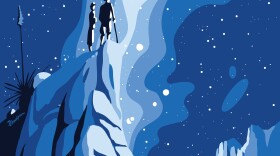
Robert Krulwich
Robert Krulwich works on radio, podcasts, video, the blogosphere. He has been called "the most inventive network reporter in television" by TV Guide.
Krulwich is the co-host of WNYC's Radiolab, a radio/podcast series distributed nationally by NPR that explores new developments in science for people who are curious but not usually drawn to science shows. Radiolab won a Peabody Award in 2011.
His specialty is explaining complex subjects, science, technology, economics, in a style that is clear, compelling and entertaining. On television he has explored the structure of DNA using a banana; on radio he created an Italian opera, "Ratto Interesso" to explain how the Federal Reserve regulates interest rates; he has pioneered the use of new animation on ABC's Nightline and World News Tonight.
For 22 years, Krulwich was a science, economics, general assignment and foreign correspondent at ABC and CBS News.
He won Emmy awards for a cultural history of the Barbie doll, for a Frontline investigation of computers and privacy, a George Polk and Emmy for a look at the Savings & Loan bailout online advertising and the 2010 Essay Prize from the Iowa Writers' Workshop.
Krulwich earned a Bachelor of Arts degree in history from Oberlin College and a law degree from Columbia University.
-
There are animals famous for their songs. Whales sing. Birds sing. We humans have Aretha, Elvis, Ray Charles, Pavarotti. But bats — who knew?
-
Let's compare two kinds of nothing: an empty patch of deep space and an empty piece of paper that was once beautiful. There's nothing to see in either. Or is there?
-
They are small. They are weak. They are vulnerable. But these little bees take on a humongous predator in the most ingenious way.
-
Can a colicky baby's piercing scream be militarized? As in, made (literally) into a weapon of war? Oh, absolutely, says this scholar, smiling ever so slightly.
-
Draw a planet (a circle, right?). Now draw a star (a pointy thing, yes?). Now ask yourself, aren't stars all round? Our sun is. So why do we make them pointy? Come learn the answer.
-
Every fall, birds head south and, around Sept. 11, New York sends two beams into the sky. When birds and lights collide, that could mean trouble — but New York is surprisingly gentle.
-
We live on a planet, next to a star that's part of a galaxy that's part of ... ah, here comes the new discovery. We are at the very tip of a giant galactic "supercluster." Take a look.
-
I am made of atoms — 7,000 trillion trillion of them. How did I teach them to tie my shoes? Or did they teach me?
-
You don't get to see this too often: a man (in this case, a very talented man) totally possessed by his muse. Watch pianist Glenn Gould deep in what psychologists call "a flow state."
-
You look. You gape. You can't believe your eyes. Well, take a peek at this image and ask yourself, 'How did they do this?'







